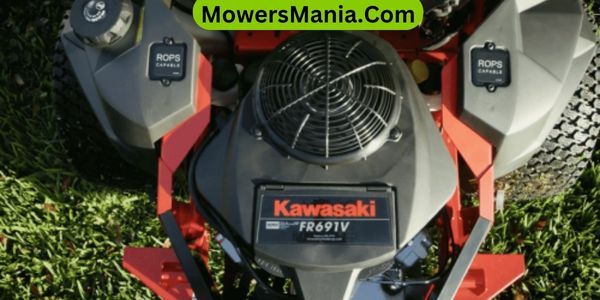Are you wondering how long your Kawasaki engine will last? Well, you’re in luck! In this article, we’ll explore the factors that can affect the lifespan of your Kawasaki engine, as well as provide you with the average lifespan and maintenance tips to help extend its longevity.

We’ll also cover signs that indicate your engine may need replacement and offer advice on how to maximize the hours on your Kawasaki engine.
So, let’s dive in and get your engine running smoothly for years to come!
Factors Affecting Kawasaki Engine Lifespan
To maximize the lifespan of your Kawasaki engine, several key factors must be considered and properly managed.
First and foremost, regular maintenance is crucial. Make sure you follow the manufacturer’s guidelines for oil changes, air filter replacements, and spark plug inspections. Neglecting these routine tasks can lead to engine wear and reduced performance.
Another factor to consider is proper fuel management. Using clean, high-quality fuel and regularly checking the fuel filter can prevent engine damage caused by contaminants.
It’s also important to avoid using old or stale fuel, as this can lead to carburetor issues and poor engine performance.
Proper storage is another key factor in extending the lifespan of your Kawasaki engine. When not in use, ensure that the engine is stored in a dry and clean environment. Use a fuel stabilizer to prevent fuel degradation and remove the spark plug to prevent corrosion.
Lastly, using the engine within its recommended operating conditions is crucial. Avoid overloading the engine, running it at excessively high speeds, or subjecting it to extreme temperatures. These actions can put unnecessary stress on the engine and shorten its lifespan.
Kawasaki FR730V-S00 24 HP 726cc Vertical V-Twin Engine
Average Lifespan of Kawasaki Engines
The average lifespan of Kawasaki engines can vary depending on various factors such as regular maintenance, fuel management, proper storage, and adherence to recommended operating conditions.
When these factors are properly addressed, a well-maintained Kawasaki engine can last for many years. On average, you can expect a Kawasaki engine to last between 1,500 to 2,000 hours of use.
However, with proper care and maintenance, some engines have been known to last even longer, surpassing the 2,000-hour mark.
Regular maintenance is crucial in ensuring the longevity of your Kawasaki engine. This includes frequent oil changes, replacing air filters, and inspecting and adjusting the spark plugs. It’s also important to properly manage the fuel system by using clean, high-quality fuel and regularly cleaning or replacing the fuel filter.
Proper storage of your Kawasaki engine during periods of non-use is equally important. This includes storing it in a clean and dry area, ensuring it’s protected from extreme temperatures and humidity.
It’s also recommended to run the engine for a few minutes every month to prevent any build-up of deposits or moisture.
Lastly, following the manufacturer’s recommended operating conditions is essential. Avoid pushing the engine beyond its limits and be mindful of any warning signs or abnormal noises during operation.
By taking these precautions and giving your Kawasaki engine the care it deserves, you can ensure a longer lifespan and reliable performance for years to come.
Maintenance Tips to Extend Kawasaki Engine Lifespan

To extend the lifespan of your Kawasaki engine, follow these maintenance tips.
First and foremost, regular oil changes are essential. Make sure to check the oil level frequently and change it according to the manufacturer’s recommendations. This will ensure proper lubrication and prevent engine damage.
Additionally, keep an eye on the air filter and clean or replace it as needed. A dirty air filter can restrict airflow and lead to poor engine performance.
Another important maintenance tip is to inspect and clean the spark plug regularly. A dirty or worn-out spark plug can cause starting issues and decrease fuel efficiency.
It’s also crucial to maintain proper fuel quality. Always use fresh, clean fuel and avoid storing it for long periods. Stale fuel can clog the carburetor and fuel lines, leading to engine problems.
Lastly, don’t forget to perform regular maintenance tasks such as checking the cooling system, adjusting valve clearances, and inspecting the belts and hoses.
Signs Your Kawasaki Engine May Need Replacement
If your Kawasaki engine is showing any of these signs, it may be time to consider replacing it.
Here are four indicators that your engine may need replacement:
- Excessive smoke: If you notice thick, black smoke coming from your engine exhaust, it could be a sign of serious issues. This could indicate problems with the fuel system, oil leakage, or worn-out piston rings. Replacing the engine may be a more cost-effective solution than trying to fix these issues.
- Loss of power: If your engine is struggling to generate the same amount of power it used to, it could be a sign of internal damage or wear. This can happen over time due to worn-out components or improper maintenance. If your engine’s performance has significantly declined, it may be time to replace it.
- Constant overheating: If your engine consistently runs hot, despite proper cooling system maintenance, it could be a sign of underlying problems. Overheating can cause severe damage to internal components, such as the cylinder head or piston. If your engine regularly overheats, it may be more cost-effective to replace it rather than continuously repairing it.
- Excessive oil consumption: If your engine is burning or leaking oil at an abnormal rate, it may be a sign of internal damage or worn-out seals. Continuously topping up oil or dealing with oil leaks can become a hassle and may not be a sustainable solution. In such cases, replacing the engine is often the best course of action.
Keep an eye out for these signs, as they may help you determine when it’s time to replace your Kawasaki engine.
How to Maximize the Hours on Your Kawasaki Engine?

To maximize the hours on your Kawasaki engine, regularly perform routine maintenance and follow proper operating procedures. By taking these steps, you can ensure that your engine runs smoothly and efficiently for a longer period of time.
First and foremost, make sure to change the oil and oil filter at recommended intervals. This will help keep the engine lubricated and prevent any build-up of dirt or debris that could potentially cause damage.
Additionally, regularly check and replace the air filter as needed, as a clogged filter can restrict airflow and put unnecessary strain on the engine.
Another important aspect of engine maintenance is keeping the cooling system in good working condition. This means regularly checking the coolant levels, ensuring that there are no leaks, and cleaning the radiator fins to prevent overheating.
In addition to routine maintenance, it’s crucial to follow proper operating procedures. Avoid overloading the engine or pushing it beyond its recommended limits. Be mindful of the engine’s temperature and avoid running it at excessively high speeds for extended periods of time.
Frequently Asked Questions [FAQs]
Can I Use Any Type of Fuel in My Kawasaki Engine?
You can use any type of fuel in your Kawasaki engine as long as it meets the manufacturer’s recommendations. Using the right fuel will help ensure optimal performance and longevity for your engine.
How Often Should I Change the Oil in My Kawasaki Engine?
You should change the oil in your Kawasaki engine regularly to ensure optimal performance. Regular oil changes help to prevent engine wear and prolong the life of your engine.
Does the Age of My Kawasaki Engine Affect Its Lifespan?
The age of your Kawasaki engine can affect its lifespan. Older engines may have more wear and tear, which could lead to a shorter lifespan. Regular maintenance and care can help prolong its life.
Can I Use Aftermarket Parts to Repair My Kawasaki Engine?
Yes, you can use aftermarket parts to repair your Kawasaki engine. However, it’s important to ensure that the parts you choose are compatible and of high quality to maintain the engine’s longevity.
Are Kawasaki Engines More Durable Than Other Brands?
Kawasaki engines are known for their durability. They can withstand rigorous use and are often more long-lasting than engines from other brands. However, the specific number of hours a Kawasaki engine will last can vary depending on various factors.
Conclusion
In conclusion, the lifespan of a Kawasaki engine can vary depending on several factors, including maintenance and usage. On average, these engines can last for several thousand hours.
However, regular maintenance and proper care can significantly extend their lifespan. It’s important to look out for signs of wear and tear and address them promptly to avoid the need for engine replacement.
By following maintenance tips and maximizing usage hours, you can ensure a longer lifespan for your Kawasaki engine.




